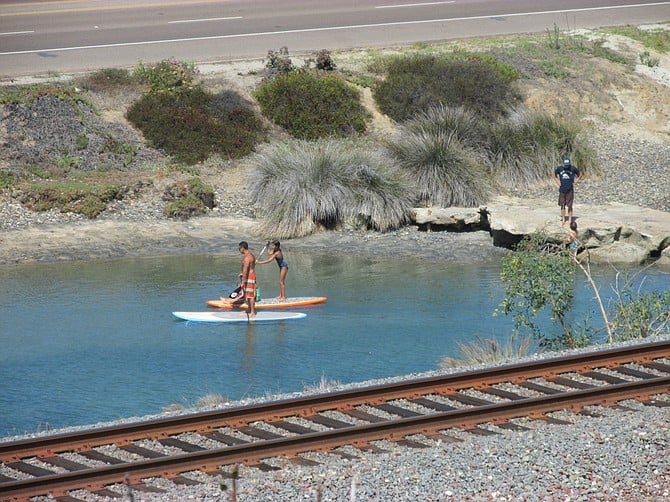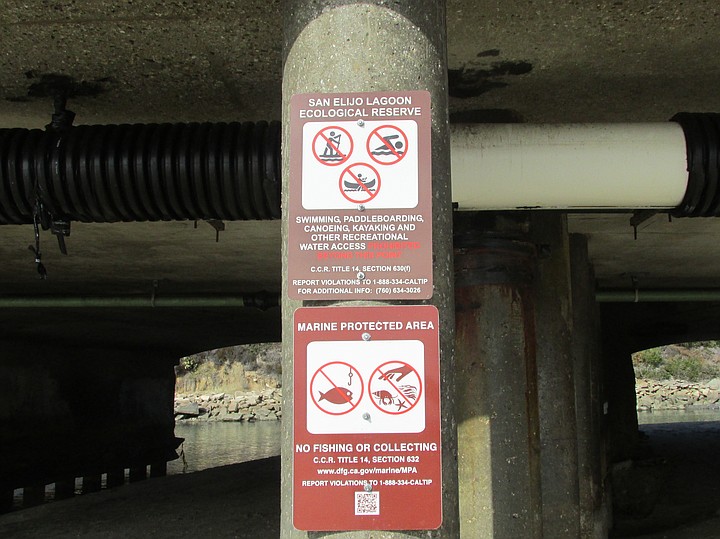 Facebook
Facebook
 X
X
 Instagram
Instagram
 TikTok
TikTok
 Youtube
Youtube

For decades, kids and families have made recreational use of the front channel of San Elijo Lagoon’s mouth, between Coast Highway 101 and the railroad tracks, south to behind Restaurant Row. It’s less crowded than Cardiff State Beach across the street, the water is warmer than the ocean, and it’s generally wave-free (except for larger-than-normal tides).
The still water is a perfect place for little kids to splash, play, throw sand, and for grown-ups to practice balancing on paddleboards or in kayaks.
Because the lagoon intake is part of the San Elijo Ecological Preserve, it has been state-protected water for years. Now, due to increased regulations, using the area could be considered trespassing, a misdemeanor.
Marine Protection Areas, enacted in 2012, affect approximately 2351 square miles of ocean, estuary, and offshore island waters, from Point Conception to the Mexican border; 50 new or revised areas have recently been implemented.
The San Elijo Lagoon is now part of a new overlay of environmental protection, one of a few new categories. Known as the San Elijo Lagoon State Marine Conservation Area, the new category offers multi-agency protection by state Dept. of Fish and Wildlife game wardens, the city, county, and the nonprofit San Elijo Lagoon Conservancy.

So, who put up the new signs recently, under the Coast Highway 101 bridge at the mouth of the lagoon on Cardiff State Beach, advising that it is now against the law to enter the lagoon’s front channel? One sign advises no taking of fish, shells, sea creatures, or plant life. The other advises, “Swimming, paddelboarding, canoeing, kayaking, or other recreational access is prohibited.” A tip-line phone number is also posted to report violators.
The state parks superintendent for northern San Diego County, Robin Greene, said, “It wasn’t us. Our jurisdiction ends at Coast Hwy. 101.”
After phone calls made to state offices in San Diego, Sacramento, and Monterey, Dept. of Fish and Wildlife Lt. Scott Bringman, a wildlife game warden, visited the site and reported, “DFW didn’t post them, but they are correctly worded for the MPA,” he said. He explained that the signs probably came through a collaborative effort of area agencies.
Other signs have recently been posted up and down the coast, both educational and regulatory, including at Encinitas’ Moonlight Beach, for the Swami’s Marine Protected Area, which extends down to Seaside beach.
Fishermen and kayakers have in the past railed against expensive trespassing tickets in area lagoons; areas that previously had not been posted. It’s the old “ignorance is no excuse for breaking the law” story.
On August 29, I asked folks using the lagoon channel if they saw the new signs that restricted access. None did. Twelve-year old Christine from Encinitas said if a warden told her and her friends to leave, they would, but, “The same animals they are trying to protect also are on the other side, in the ocean,” she said.
Rene, from O.B., who has a degree in biology, was going paddleboarding in the channel with friends. “The effects of human activity here is nil,” she said. “Of course we respect the need to protect our resources, but surfers and water people are very environmentally conscious.”
Lt. Bringman said he encourages his wardens, if needed, to give just warnings. “Realistically, someone would have to be doing something pretty egregious for a warden to write a ticket [in the San Elijo channel],” he said. Should that come to pass, as of January 2016, the misdemeanor citation will become only infractions, something that would not stay on one’s record, said Bringman.
For regulations, maps, and GPS coordinates of all the Southern California Marine Protection Areas, download the Dept. of Fish and Wildlife’s update.


For decades, kids and families have made recreational use of the front channel of San Elijo Lagoon’s mouth, between Coast Highway 101 and the railroad tracks, south to behind Restaurant Row. It’s less crowded than Cardiff State Beach across the street, the water is warmer than the ocean, and it’s generally wave-free (except for larger-than-normal tides).
The still water is a perfect place for little kids to splash, play, throw sand, and for grown-ups to practice balancing on paddleboards or in kayaks.
Because the lagoon intake is part of the San Elijo Ecological Preserve, it has been state-protected water for years. Now, due to increased regulations, using the area could be considered trespassing, a misdemeanor.
Marine Protection Areas, enacted in 2012, affect approximately 2351 square miles of ocean, estuary, and offshore island waters, from Point Conception to the Mexican border; 50 new or revised areas have recently been implemented.
The San Elijo Lagoon is now part of a new overlay of environmental protection, one of a few new categories. Known as the San Elijo Lagoon State Marine Conservation Area, the new category offers multi-agency protection by state Dept. of Fish and Wildlife game wardens, the city, county, and the nonprofit San Elijo Lagoon Conservancy.

So, who put up the new signs recently, under the Coast Highway 101 bridge at the mouth of the lagoon on Cardiff State Beach, advising that it is now against the law to enter the lagoon’s front channel? One sign advises no taking of fish, shells, sea creatures, or plant life. The other advises, “Swimming, paddelboarding, canoeing, kayaking, or other recreational access is prohibited.” A tip-line phone number is also posted to report violators.
The state parks superintendent for northern San Diego County, Robin Greene, said, “It wasn’t us. Our jurisdiction ends at Coast Hwy. 101.”
After phone calls made to state offices in San Diego, Sacramento, and Monterey, Dept. of Fish and Wildlife Lt. Scott Bringman, a wildlife game warden, visited the site and reported, “DFW didn’t post them, but they are correctly worded for the MPA,” he said. He explained that the signs probably came through a collaborative effort of area agencies.
Other signs have recently been posted up and down the coast, both educational and regulatory, including at Encinitas’ Moonlight Beach, for the Swami’s Marine Protected Area, which extends down to Seaside beach.
Fishermen and kayakers have in the past railed against expensive trespassing tickets in area lagoons; areas that previously had not been posted. It’s the old “ignorance is no excuse for breaking the law” story.
On August 29, I asked folks using the lagoon channel if they saw the new signs that restricted access. None did. Twelve-year old Christine from Encinitas said if a warden told her and her friends to leave, they would, but, “The same animals they are trying to protect also are on the other side, in the ocean,” she said.
Rene, from O.B., who has a degree in biology, was going paddleboarding in the channel with friends. “The effects of human activity here is nil,” she said. “Of course we respect the need to protect our resources, but surfers and water people are very environmentally conscious.”
Lt. Bringman said he encourages his wardens, if needed, to give just warnings. “Realistically, someone would have to be doing something pretty egregious for a warden to write a ticket [in the San Elijo channel],” he said. Should that come to pass, as of January 2016, the misdemeanor citation will become only infractions, something that would not stay on one’s record, said Bringman.
For regulations, maps, and GPS coordinates of all the Southern California Marine Protection Areas, download the Dept. of Fish and Wildlife’s update.
Comments